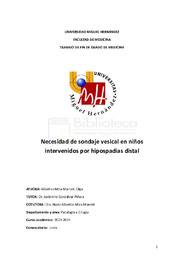Por favor, use este identificador para citar o enlazar este ítem:
https://hdl.handle.net/11000/33940Necesidad de sondaje vesical en niños intervenidos por hipospadias distal
| Título : Necesidad de sondaje vesical en niños intervenidos por hipospadias distal |
| Autor : Albertos Mira-Marcelí, Olga |
| Tutor: Gonzálvez Piñera, Jerónimo Albertos Mira-Marcelí, Nuria |
| Editor : Universidad Miguel Hernández |
| Departamento: Departamentos de la UMH::Patología y Cirugía |
| Fecha de publicación: 2024-05-12 |
| URI : https://hdl.handle.net/11000/33940 |
| Resumen : Objetivo: comparar, mediante un análisis de no inferioridad, la prevalencia de aparición de complicaciones mayores postquirúrgicas (fístula uretrocutánea (FUC) y estenosis del meatomeato) en pacientes intervenidos por hipospadias distal en un grupo con sonda vesical y otro sin ella durante el periodo postoperatorio. Material y métodos: se trata de un ensayo clínico clínico, aleatorizado y controlado. Se incluyen pacientes (0 a 14 años) que re quieran intervención por hipospadias distal que se aleatorizan a grupo “con sonda” (grupo C) o grupo “sin sonda” (grupo S). Se recogen variables durante la visita preguirúrgica, durante el ingreso hospitalario y tras el alta . Las variables principales son las complicaciones mayores postquirúrgicas (FUC y estenosis meatalmeatal). Resultados: no se obtienen diferencias estadísticamente significa tivas en las variables descriptivas entre los grupos, por lo que son estadísticamente comparables. N o se observan diferencias estadísticamente significativas en las complicaciones mayores postquirúrgicas ni en el resto de complicaciones menores medidas durante el seguimiento. Se enc uentran diferencias estadísticamente significativas en la frecuencia de espasmos vesicales ( 14 % grupo C, 0% grupo S, 7% no consta; p= 0,0 0,02), en la administración de fármacos anticolinérgicos postoperatorios ( 68% grupo C, 0% grupo S; p < 0,001), en la duración de la antibioterapia (dosis intraoperatoria en 95 % grupo S, 48 h en 9 90% grupo C y 72 h en 5% grupo C , no consta en 4%; p < 0,001), en la presencia de disuria durante el ingreso (4 5% grupo C, 10% grupo S S, 5% no consta ; p = 0,0 0,01) y en la duración del mismo ( mediana 57 h grupo C, mediana 12 h grupo S; p < 0,001) 0,001). Conclusiones: en el presente estudio, prescindir de sonda vesical en el postoperatorio de l hipospadias distal no incrementa la tasa de complicaciones postquirúrgicas postquirúrgicas, por lo que es una práctica segura segura. Además, asocia otras ventajas como la reducción de la disuria postoperatoria , de los fármacos y la morbilidad (espasmos vesicales) asociados al uso de sonda y de la duración del ingreso hospitalario hospitalario, con la consiguiente reducción de costes costes. Tras estos resultados, se recomienda un cambio de paradigma en el manejo del hipospadias distal , ya que no es necesario el uso de sonda vesical tras la intervención Objective: to compare, by means of a non-inferiority analysis, the prevalence of occurrence of major postoperative complications (urethrocutaneous fistula (UCF) and meatal stenosis) in patients operated on for distal hypospadias in a group with a urethral stent and another without it during the postoperative period. Materials and methods: this is a randomized, controlled clinical trial. Patients (0 to 14 years) requiring intervention for distal hypospadias were randomized to the "with stent" group (group C) or "without stent" group (group S). Variables were collected during the pre-surgical visit, during hospital admission and after discharge. The main variables are major postoperative complications (UCF and meatal stenosis). Results: no statistically significant differences were obtained in the descriptive variables between the groups, so they are statistically comparable. No statistically significant differences were observed in the major postoperative complications or in the rest of the minor complications measured during follow-up. Statistically significant differences were found in the frequency of baldder spasms (14% group C, 0% group S, 7% not recorded; p= 0.02), in the administration of postoperative anticholinergic drugs (68% group C, 0% group S; p < 0.001), in the duration of antibiotherapy (intraoperative dose in 95% group S, 48 h in 90% group C and 72 h in 5% group C, not recorded in 4%; p < 0.001), in the presence of dysuria during admission (45% group C, 10% group S, 5% not recorded; p = 0.01) and in the duration of admission (median 57 h group C, median 12 h group S; p < 0.001). Conclusion: in the present study, dispensing with urethral stenting in the postoperative period for distal hypospadias does not increase the rate of postoperative complications, making it a safe practice. In addition, it has other advantages such as the reduction of postoperative dysuria, of the drugs and morbidity (bladder spasms) associated with stent use and of the duration of hospital stay, with the consequent reduction of costs. Following these results, a paradigm shift in the management of distal hypospadias is recommended, since it is not necessary to use a urethral stent after the intervention. |
| Palabras clave/Materias: hipospadias distal sonda vesical complicaciones postquirúrgicas niños |
| Área de conocimiento : CDU: Ciencias aplicadas: Medicina |
| Tipo de documento : info:eu-repo/semantics/bachelorThesis |
| Derechos de acceso: info:eu-repo/semantics/openAccess |
| Aparece en las colecciones: TFG- Medicina |
 La licencia se describe como: Atribución-NonComercial-NoDerivada 4.0 Internacional.
La licencia se describe como: Atribución-NonComercial-NoDerivada 4.0 Internacional.
.png)
